Content
1. Brief Overview of the Evolution of Game Testing
2. List of Different Types of Game Testing
3. The Role of Emotional Testing in Games
4. Different Aspects of Emotional Testing
5. Ensuring Accessibility and Inclusivity in Game Testing
6. Strategies for Testing Games for Accessibility and Inclusivity
7. The Future of Game Testing
8. Upcoming Advancements in Game Testing Technology
9. Conclusion
Game testing is often mistakenly seen as simply searching for bugs and glitches in video games in the United Kingdom (UK). However, it is much more than that. Game testing plays a vital role in ensuring the overall quality, performance, and user experience of a game. It involves a comprehensive evaluation of various aspects, including gameplay mechanics, level design, graphics, audio, controls, and overall balance.
Beyond technical assessments, game testing also involves user experience testing. Testers assess how the game feels and flows from the perspective of a player, focusing on aspects such as intuitive controls, responsive gameplay, and captivating storytelling.
In this blog post, we will delve into the multifaceted nature of game testing in the UK, highlighting its significance and the various dimensions it encompasses beyond mere bug hunting.
Brief Overview of the Evolution of Game Testing

The evolution of game testing can be traced back to the early days of video games when the testing was primarily done manually by the developers themselves. As the video game industry grew, testing became a specialized field with the rise of game testing companies in the 1990s. During this period, testing primarily focused on functionality and compatibility issues. With the introduction of online gaming, game testing became more complex and shifted towards network and security testing.
The mobile gaming boom in the 2000s led to a new set of challenges for game testers, such as compatibility with various devices and app stores. Today, game testing has evolved to include emotional testing, user experience testing, and accessibility testing, among others. The rise of virtual reality and augmented reality has also presented new challenges for game testers, including motion sickness and latency issues. As the gaming industry continues to evolve, game testing will remain a critical aspect of game development to ensure that games meet user expectations and deliver an optimal gaming experience.
List of Different Types of Game Testing
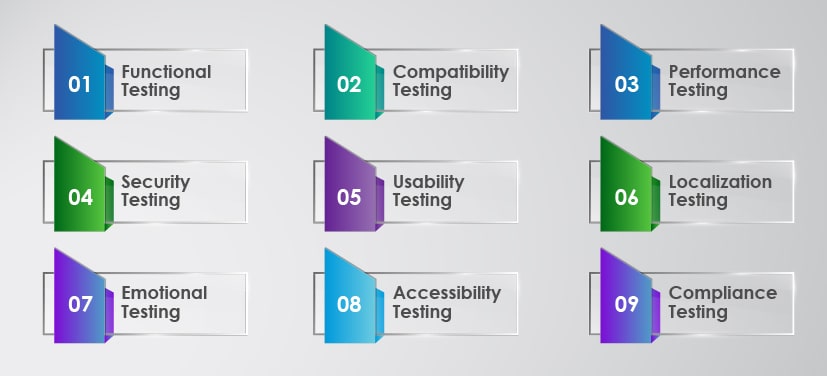
Game testing involves evaluating the quality, functionality, and user experience of a game. There are different types of game testing, each with its own specific focus and goals. Here are some of the main types of game testing:
Functional Testing:
This type of testing ensures that the game functions as intended, with all features and functions working as they are intended to.
Compatibility Testing:
This type of testing involves evaluating the game’s compatibility with different platforms, devices, and software versions.
Performance Testing:
This type of testing measures the game’s performance in terms of speed, responsiveness, and stability under various conditions.
Security Testing:
This type of testing evaluates the game’s ability to protect against unauthorized access, cheating, hacking, and other security threats.
Usability Testing:
This type of testing focuses on the game’s ease of use, including navigation, controls, and overall user experience.
Localization Testing:
This type of testing ensures that the game is culturally appropriate and adapted for different regions and languages.
Emotional Testing:
This type of testing evaluates the emotional response of players to a game, measuring factors such as engagement, satisfaction, and likelihood of recommending the game to others.
Accessibility Testing:
This type of testing ensures that the game is accessible to players with disabilities, including visual, auditory, and motor impairments.
Compliance Testing:
This type of testing ensures that the game adheres to legal and regulatory requirements, such as age ratings and content restrictions.
By conducting various types of game testing, developers can ensure that their games meet high standards for quality, functionality, and user experience.
The Role of Emotional Testing in Games

Emotional testing is an essential aspect of game testing that evaluates the emotional responses of players to a game. Emotional testing involves measuring how a game makes players feel, their level of engagement, and how likely they are to recommend the game to others. This type of testing allows game developers to understand how players react to different aspects of the game, such as the storyline, characters, and game mechanics.
Emotional testing can help developers identify what elements of the game are most appealing to players and what needs improvement. By testing emotional responses, developers can ensure that players are fully engaged with the game, leading to better retention rates and increased revenue. In addition, emotional testing can help create more immersive and memorable game experiences. Overall, emotional testing is an essential tool for game developers to create games that not only function well but also deliver an emotional impact on players.
Different Aspects of Emotional Testing
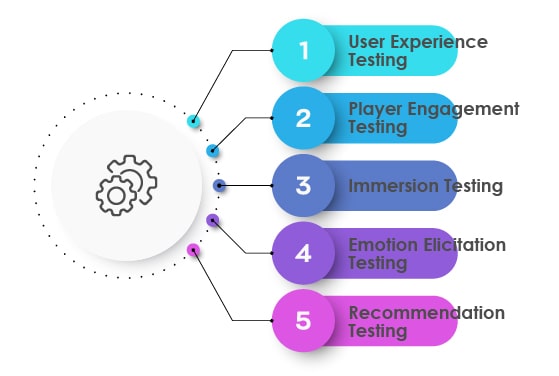
Emotional testing includes various aspects that help measure the overall user experience and player engagement. Here are some of the key aspects of emotional testing:
User Experience Testing:
This type of testing measures the overall user experience of the game, including the ease of use, navigation, and overall enjoyment of the game.
Player Engagement Testing:
This type of testing measures the level of player engagement with the game, including how long players spend playing the game and how often they return to play again.
Immersion Testing:
This type of testing evaluates the game’s ability to create an immersive experience for players, including how well the game’s story, characters, and world-building engage players.
Emotion Elicitation Testing:
This type of testing measures the game’s ability to evoke different emotions in players, such as excitement, joy, and suspense.
Recommendation Testing:
This type of testing measures the likelihood that players would recommend the game to others, based on their emotional response to the game. By conducting emotional testing in these different aspects, game developers can gain insights into how their game is perceived by players and identify areas that need improvement. Emotional testing helps ensure that games not only function well but also provide an engaging and emotionally impactful experience for players.
Ensuring Accessibility and Inclusivity in Game Testing
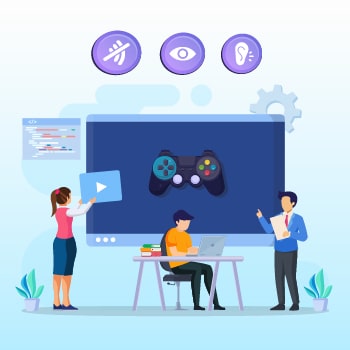
Ensuring accessibility and inclusivity in game testing is an essential aspect of game development. Accessibility testing involves evaluating the game’s ability to accommodate players with disabilities, including visual, auditory, and motor impairments. Inclusivity testing involves evaluating the game’s ability to appeal to a diverse range of players, including those from different cultures, genders, and backgrounds.
To ensure accessibility in game testing, developers should consider factors such as color contrast, font size, and the use of audio cues. Game developers can also implement features such as adjustable difficulty settings, subtitles, and alternative input methods such as voice recognition or eye-tracking technology.
Strategies for Testing Games for Accessibility and Inclusivity
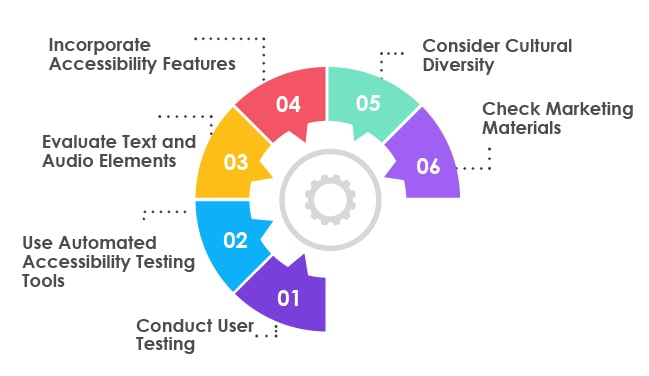
Testing games for accessibility and inclusivity requires specific strategies to ensure that all players can enjoy the game, regardless of their abilities or backgrounds. Here are some strategies that game developers can use to test games for accessibility and inclusivity:
Conduct User Testing:
To ensure accessibility and inclusivity, developers should conduct user testing with a diverse range of players, including those with disabilities and players from different backgrounds. This allows developers to gain insights into how players with different needs interact with the game and identify any issues that need to be addressed.
Use Automated Accessibility Testing Tools:
There are various automated accessibility testing tools available that can help developers identify accessibility issues in their game, such as color contrast, keyboard accessibility, and audio description.
Evaluate Text and Audio Elements:
Developers should ensure that all text and audio elements in the game are easily readable and audible, including captions, subtitles, and audio descriptions.
Incorporate Accessibility Features:
Developers should incorporate accessibility features into the game, such as adjustable difficulty settings, alternative input methods, and color-blind mode.
Consider Cultural Diversity:
Developers should ensure that the game’s storylines and characters are culturally appropriate and appealing to a diverse range of players.
The future of game testing is evolving rapidly, driven by advancements in technology and changing consumer expectations. According to a report by MarketsandMarkets, the global game testing market size is expected to grow from $5.5 billion in 2020 to $9.2 billion by 2025, at a compound annual growth rate (CAGR) of 10.8%. This growth is being driven by the increasing adoption of cloud-based game testing and the rising demand for game testing across multiple platforms, including consoles, PCs, and mobile devices.
One of the key trends in the future of game testing in the United Kingdom is the integration of artificial intelligence (AI) and machine learning (ML) technologies. These technologies enable game developers to automate testing processes, identify and fix bugs more quickly, and improve the overall quality of the game. According to a report by ResearchAndMarkets, the global AI in gaming market size is expected to grow from $336 million in 2020 to $4.5 billion by 2027, at a CAGR of 40.5%.
Another trend in the future of game testing is the increasing importance of player feedback and community engagement. Game developers are increasingly turning to online communities and social media platforms to gather feedback from players and incorporate their suggestions into game development. This approach not only helps improve the overall quality of the game but also fosters a stronger connection between players and game developers.
Upcoming Advancements in Game Testing Technology
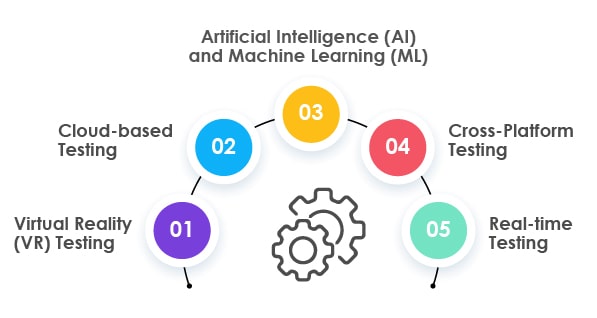
Advancements in technology are transforming the field of game testing, enabling developers to improve the quality and efficiency of their testing processes. Here are some of the upcoming advancements in game testing technology:
Virtual Reality (VR) Testing:
VR is becoming increasingly popular in the gaming industry, and as such, there is a growing need for effective testing of VR games. VR testing can help identify issues such as motion sickness and ensure that the game provides a comfortable and enjoyable experience for players.
Cloud-based Testing:
Cloud-based game testing enables developers to test games across multiple platforms simultaneously, without the need for physical hardware. This can help reduce costs and improve testing efficiency, as developers can access a wide range of devices and platforms remotely.
Artificial Intelligence (AI) and Machine Learning (ML):
AI and ML are increasingly being used in game testing to automate testing processes, identify bugs, and provide insights into player behavior. This can help reduce testing time and improve the overall quality of the game.
Cross-Platform Testing:
Cross-platform testing enables developers to test games across multiple platforms, including consoles, PCs, and mobile devices. This can help ensure that the game provides a consistent and enjoyable experience for players, regardless of the platform they are using.
Real-time Testing:
Real-time testing allows developers to test games as they are being developed, enabling them to identify and fix issues more quickly. This approach can help reduce development time and improve the overall quality of the game.
These advancements in game testing technology are set to revolutionize the way games are tested, making the process more efficient, effective, and cost-effective.
Conclusion
Game testing is much more than just bug hunting. The evolution of game testing has led to the emergence of various types of testing, including functional, non-functional, and emotional testing, all of which are critical for ensuring that games are of high quality and provide an engaging and enjoyable experience for players. Moreover, with the increasing demand for accessibility and inclusivity in games, testing for these aspects has become crucial for ensuring that games are accessible to a wide range of players, including those with disabilities.
As the gaming industry continues to grow and evolve, game testing will remain a vital aspect of game development. The future of game testing looks promising, with advancements in technology such as VR, AI, and cloud-based testing, and the increasing importance of player feedback and community engagement.
In essence, game testing is a collaborative effort that involves game developers, testers, and players, all working together to create the best possible gaming experience. By prioritizing quality and inclusivity in game testing, we can ensure that games are not just entertaining, but also accessible and engaging for all players.
Looking forward to getting advanced game testing services in the UK? Get in touch with our game testing experts and we will take it from there.
The post Game Testing: More than Just Bug Hunting first appeared on TestingXperts.






